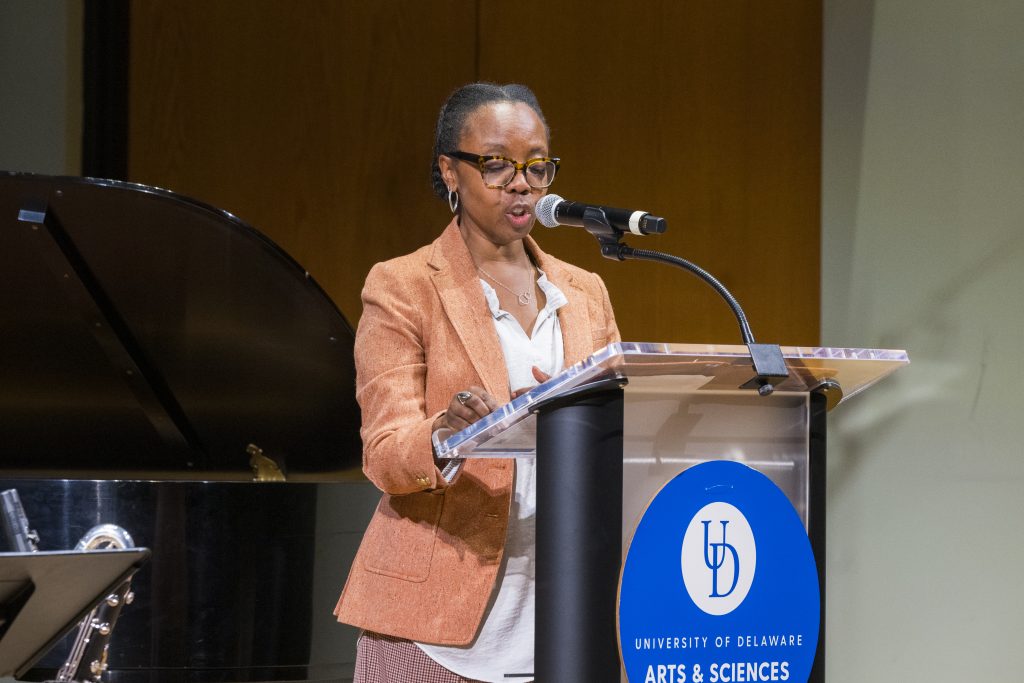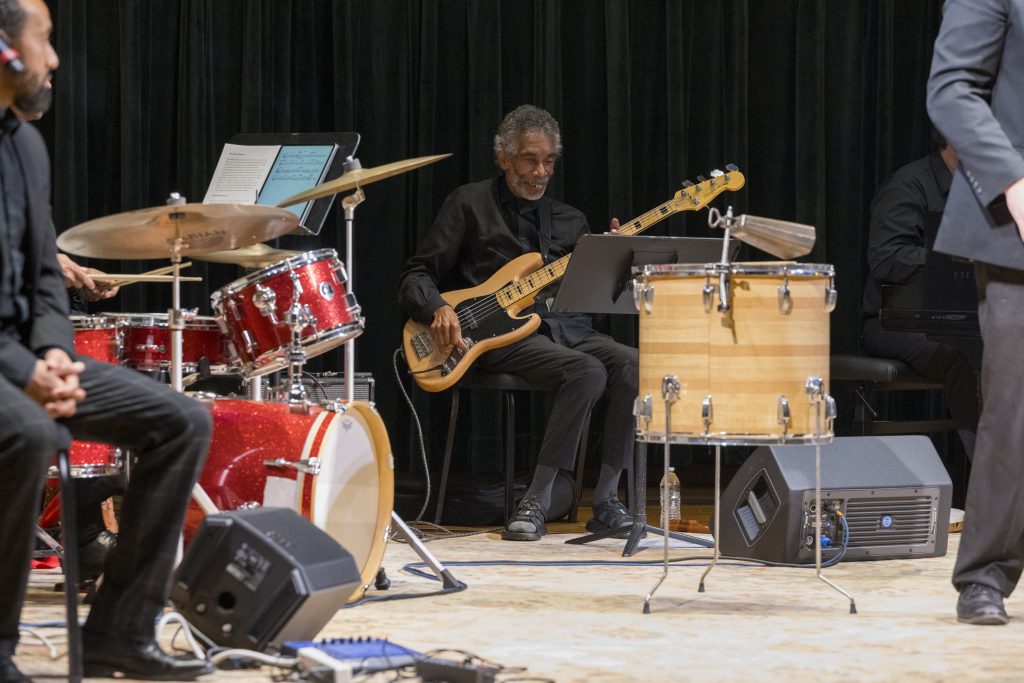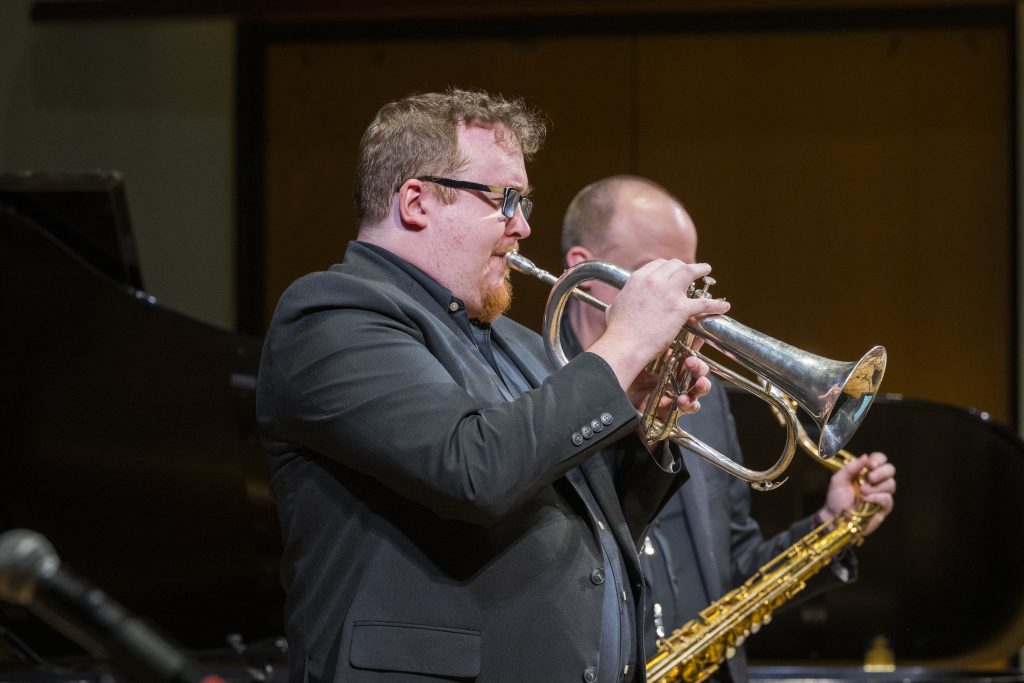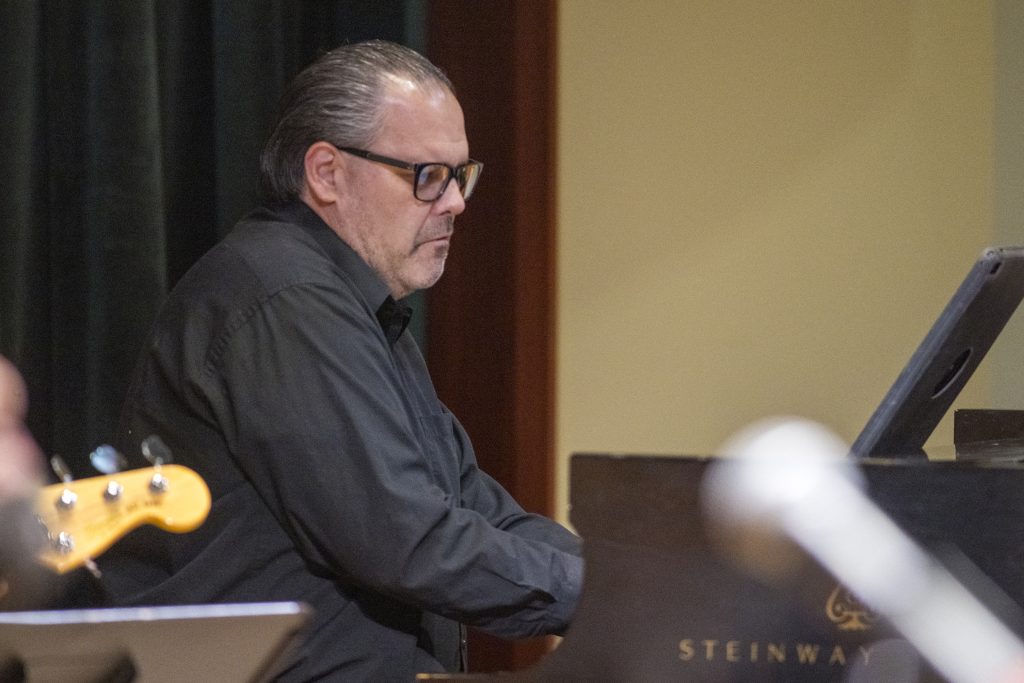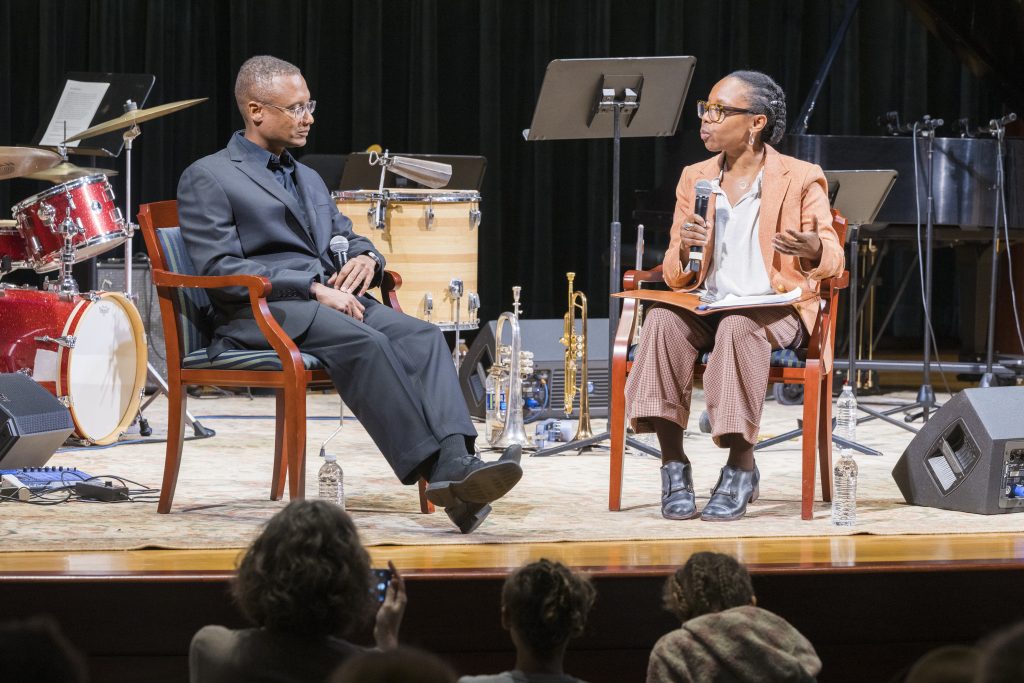
The College of Arts & Sciences (CAS) hosts the Friends of Couch’s Bridge which is the location of Delaware’s only Revolutionary War-era land battle about 4 miles from campus. Jonathan Whitney, composer and jazz drummer received a B.M. in music education and a M.A. in jazz studies from the University of Delaware, has written 11 movements to correspond with written words from the African American families both free and enslaved with the Cooch family who lived on the property for 7 generations,
Performed at the University of Delaware’s Center for the Arts, Gore Recital Hall on October 11th, Cooch’s Bridge: The African American Presence is a ten-movement jazz suite inspired by the African Americans, both free and enslaved, who lived, worked and fought on the Cooch’s Bridge Historic Site from the mid-1700s to the present. Cooch’s Bridge: The African American Presence asks many questions with answers research may not be able to prove but that humanize these amazingly resilient, strong-willed, funny, loving, sassy, hardworking, community-building men and women. Composer Jonathan W. Whitney spent hours talking to scholars and researching the many Black bodies that passed through the Cooch’s Bridge Historic Site. In doing that research, he found that there was little written history from the Black perspective; everything was written by members of the Cooch Family or other white members of the Welsh Tract community. “This is when I decided that this composition will ask questions we can’t answer through historical fact but will bring these bodies to life,” Whitney said. Cooch’s Bridge: The African American Presence brings these stories to life while speaking back into existence names that were lost to history.
About the artist
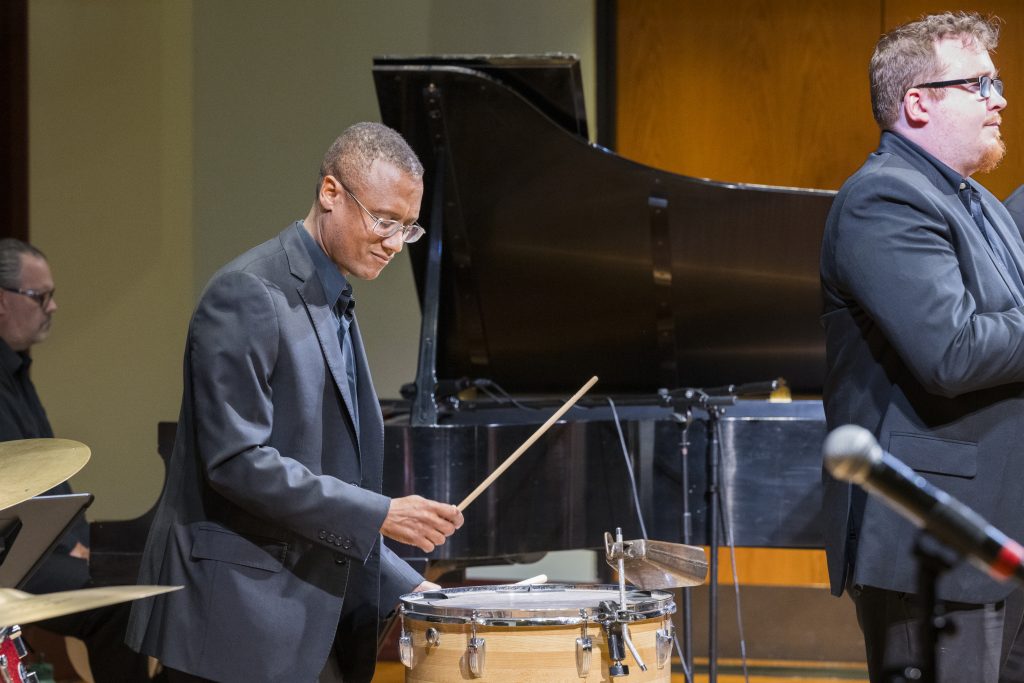 Composer and jazz drummer Jonathan W. Whitney received a B.M. in music education from the University of Delaware and an M.M. in jazz studies from the University of the Arts. He grew up in the city of Newark, where his father, a former professional drummer who owned an organ repair business, was his earliest musical influence. Whitney is the artist-in-residence at the Episcopal Church of Saints Andrew and Matthew, and he received a Delaware Established Artist Fellowship in 2020. Whitney’s compositions include Cooch’s Bridge | The Family; collaborations with the choreographer Ashley S.K. Davis to craft music for her dance works Divided We Fall (2019) and Ode (owed) to Black Women (2022); When The Two Shall Meet (2019) a large scale work written for the combined ensemble of the modern baroque ensemble Melomanie and the Whitney Project; and a separate work, Bedtime (2019), written for Melomanie.
Composer and jazz drummer Jonathan W. Whitney received a B.M. in music education from the University of Delaware and an M.M. in jazz studies from the University of the Arts. He grew up in the city of Newark, where his father, a former professional drummer who owned an organ repair business, was his earliest musical influence. Whitney is the artist-in-residence at the Episcopal Church of Saints Andrew and Matthew, and he received a Delaware Established Artist Fellowship in 2020. Whitney’s compositions include Cooch’s Bridge | The Family; collaborations with the choreographer Ashley S.K. Davis to craft music for her dance works Divided We Fall (2019) and Ode (owed) to Black Women (2022); When The Two Shall Meet (2019) a large scale work written for the combined ensemble of the modern baroque ensemble Melomanie and the Whitney Project; and a separate work, Bedtime (2019), written for Melomanie.
About Cooch’s Bridge Historic Site
The Cooch’s Bridge Historic Site is the location of Delaware’s only Revolutionary War-era land battle and sits about four miles from UD’s Newark campus. The site’s history covers centuries of early American agricultural use, industry, the Cooch family who lived on the property for seven generations, and the experience of Black families, both free and enslaved.
Composer’s Note
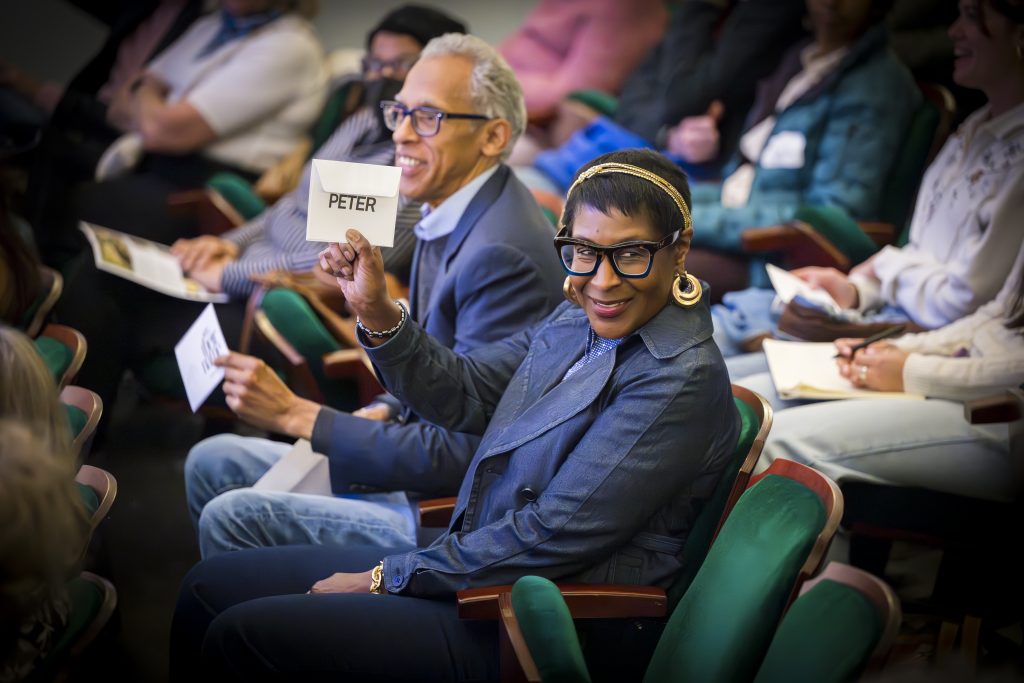 Cooch’s Bridge: The African American Presence is composed as a single work with ten movements, each inspired by a different topic: a person, a community, an act, or a relationship connected to what is now known as Cooch’s Bridge Historic Site.
Cooch’s Bridge: The African American Presence is composed as a single work with ten movements, each inspired by a different topic: a person, a community, an act, or a relationship connected to what is now known as Cooch’s Bridge Historic Site.
I selected the jazz quintet as my canvas for this work because of the sonic possibilities and the many rhythms and styles of the African diaspora that can be explored within it. My thought process has been to illuminate these Black narratives through contemporary music that expresses the complexity of history in ways that the written word cannot.
My research for this project focused on the mid-1700s to the present. Although there were likely prior examples of enslavement on the site, the earliest known document referencing an African American on the land called Cooch’s Bridge is in the 1750s, an advertisement for the capture and return of Samuel, a freedom seeker, who was enslaved by Thomas Cooch. In more than a quarter millennium since then, Black men, women, and children — both enslaved and free — were engaged with the land, the Cooch family, and the history surrounding this important historic site. Many formed the engine that provided the Cooch family with the foundation of their family wealth. They also were the genesis of lineages that still produced shining examples of Black excellence.
This work focuses on their lives and poses the question: “What was their reality?”
Historians require primary sources and written documentation to meet the burden of proof for something to be considered historically accurate. For the Cooch family, much can be proven because of their multi-generational commitment to conserving their family’s history. Some of this reveals details about the African American presence at the site. For many African Americans, our history is remembered only through the oral tradition due to the systematic refusal to teach Black men and women to read and write.
In Cooch’s Bridge: The African American Presence, I take the liberty to ask many questions with answers we can’t prove but that humanize these amazingly resilient, strong-willed, funny, loving, sassy, hardworking, community-building black men and women.
I’d like to thank the board of the Friends of Cooch’s Bridge Historic Site for commissioning this work, and especially Vince Watchorn, who has always picked up the phone and been open to connecting me with all involved in the development of the Cooch’s Bridge Historic Site. Thank you to the Delaware Division of Historical and Cultural Affairs, especially Kaitlyn Dykes and Dan Citron, for being willing to share their research openly and Wade Catts for sharing his vast knowledge on Cooch’s Bridge and its overall context. Thank you to Crystal Simms and Patty Wilson Aden, both from the Cooch’s Bridge descendant community, who generously shared their family stories and oral tradition, for which I am grateful. Finally, I thank the Cooch family for trusting me with the artistic interpretation of their family’s history and the history of the lands that they resided on for 264 years. I specifically appreciate Judge Richard R. Cooch and Anne Cooch Doran for their courageous willingness to explore and illuminate the truth. Jonathan W. Whitney Composer
Producer’s Notes
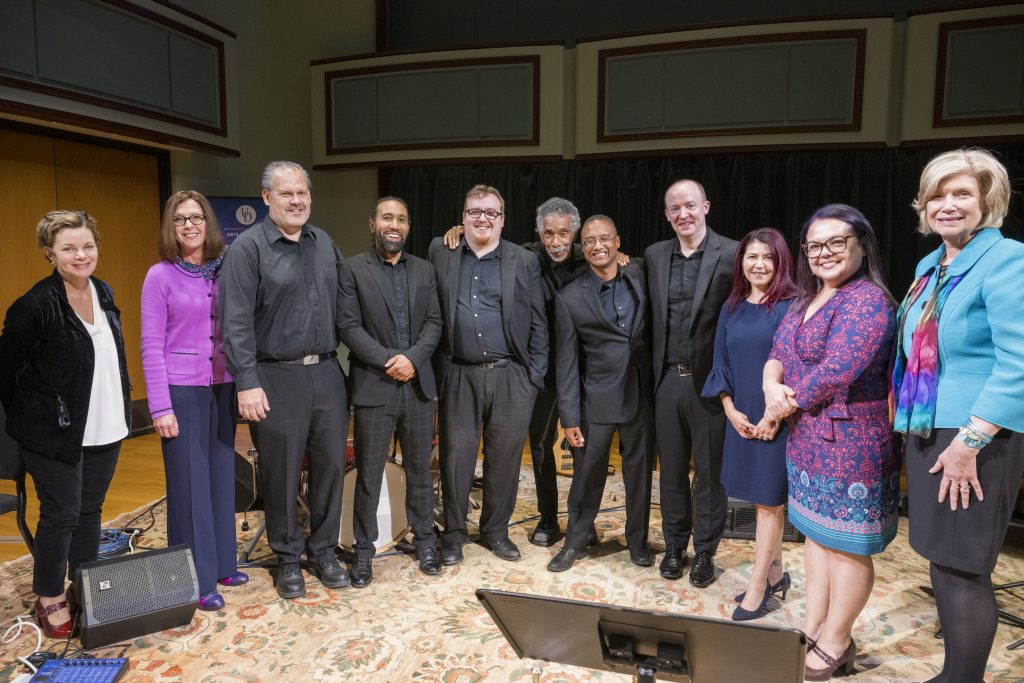 Cooch’s Bridge: The African American Presence is the second in a four-part suite of works the Friends of Cooch’s Bridge Historic Site has commissioned from composer Jonathan W. Whitney. The Govatos Quartet premiered Cooch’s Bridge: The Family at Blue Ball Barn on June 3, 2023. The next narrative to explore was the site’s African American population, which the composer chose to express through a jazz quintet in 10 movements. Cooch’s Bridge: The African American Presence premiered on April 14, 2024, at OperaDelaware Studios in Wilmington.
Cooch’s Bridge: The African American Presence is the second in a four-part suite of works the Friends of Cooch’s Bridge Historic Site has commissioned from composer Jonathan W. Whitney. The Govatos Quartet premiered Cooch’s Bridge: The Family at Blue Ball Barn on June 3, 2023. The next narrative to explore was the site’s African American population, which the composer chose to express through a jazz quintet in 10 movements. Cooch’s Bridge: The African American Presence premiered on April 14, 2024, at OperaDelaware Studios in Wilmington.
The third piece, Cooch’s Bridge: The Battle, for pipe organ and percussion, will have its World Premiere on Friday, June 6, 2025, on the Katherine Esterly Organ at the Episcopal Church of Saints Andrew and Matthew in Wilmington, with an encore performance at St. Peter’s Episcopal Church in Lewes, on Sunday, June 8, 2025. David Christopher will be the featured organist, and Jonathan Whitney will be the music director. Additional performances are being planned for Fall 2025 and 2026. Cooch’s Bridge: The Battle will also have a student workshop treatment on the Casavant Organ at the University of Redlands (CA) in March 2025, allowing the composer to hear the current draft in full and to make refinements as he approaches the final production version. The last work in the four-part suite, slated for production in 2027, will explore the historic site’s Lenape tradition.
The Friends’ goal is to ensure that Cooch’s Bridge Historic Site’s cultural heritage endures and is made relevant to the contemporary audience by bringing new music into the world.
We are extremely grateful for the opportunity to work with the dynamic, searching, and optimistic musical spirit that is Jonathan W. Whitney. His singular vision would not be realized without the support of the Delaware Division of the Arts, Delaware 250, the Founding Friends of Cooch’s Bridge Historic Site, the talented musicians of the Whitney Project, and the Friends of Cooch’s Bridge Historic Site Board of Directors. Thank you all.
And to you, the audience: thank you for listening. Thank you for honoring untold historical narratives as we elevate and amplify the voices of Delaware’s past.
Vince Watchorn President Friends of Cooch’s Bridge Historic Site
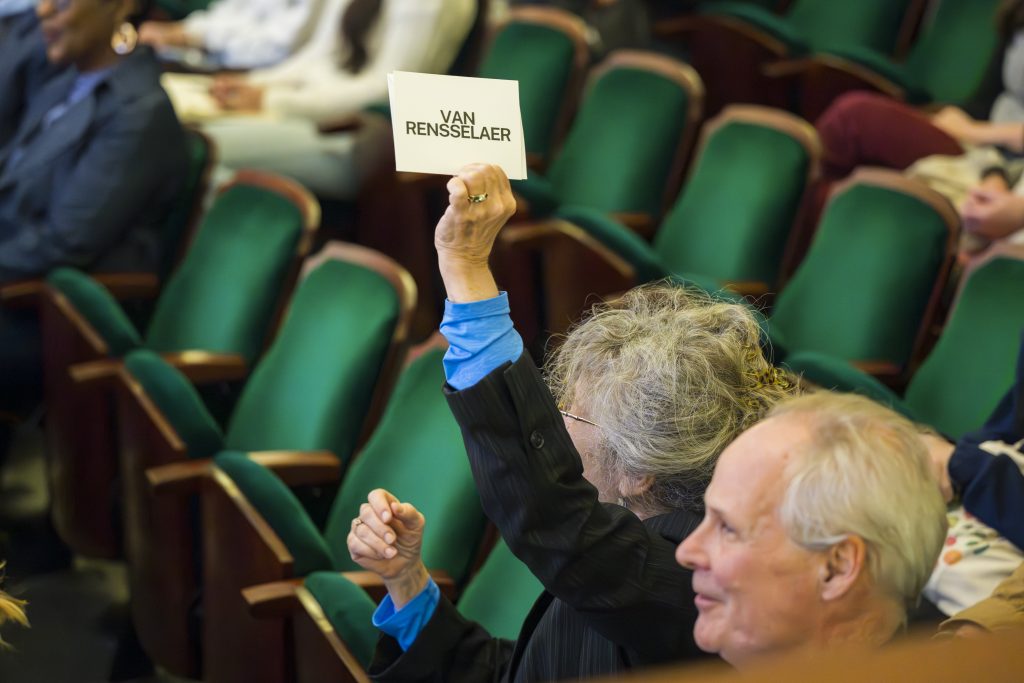 This presentation and concert of Cooch’s Bridge: The African American Presence is possible thanks to the generous support of the College of Arts and Sciences (CAS), the Departments of Anthropology, History, and Music, and the Center for Black Culture. Cooch’s Bridge: The African American Presence was originally made possible with support from Friends of Cooch’s Bridge.
This presentation and concert of Cooch’s Bridge: The African American Presence is possible thanks to the generous support of the College of Arts and Sciences (CAS), the Departments of Anthropology, History, and Music, and the Center for Black Culture. Cooch’s Bridge: The African American Presence was originally made possible with support from Friends of Cooch’s Bridge.





